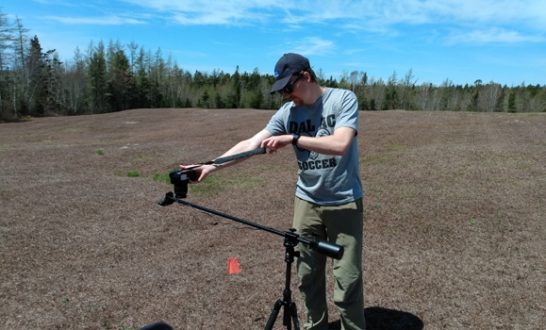Apr 27, 2021Smart tech makes farming blueberries cheaper, more environmentally friendly
The wild blueberry market has developed into a multimillion-dollar industry in North America, with consumers pushing up demand as they seek out the prized berries for a range of health benefits.
Growing and harvesting the fruit can, however, be complicated by weeds that infest commercial fields, compete with blueberry plants for nutrients and interfere with harvesting equipment. To stem the spread of unwanted plants, farmers often rely on broadcast applications of herbicides to eliminate the weeds, some of which have become resistant to the chemicals because of repeated use.
The Mechanized Systems Research Team at Dalhousie University in Halifax, Nova Scotia, Canada, is addressing that problem through the use of deep learning convolutional neural networks (CNNs) — an emerging smart technology that can identify weeds and give farmers the information they need to apply agrochemicals in a more targeted fashion.
Travis Esau, an assistant professor in the Faculty of Agriculture Department of Engineering, recently published a paper on this topic with his Ph.D. student, Patrick Hennessy. This research determined the technology could detect sheep sorrel and hair fescue — two common weeds that affect Nova Scotia blueberry crops — in images of almost 60 wild blueberry fields in the province.
“With this research we discovered how CNNs can very accurately detect the presence of hair fescue and sheep sorrel when herbicides are being applied,” said Esau said.
“As a result, we can incorporate the trained CNN into smart applicators to allow for spot treatment of agrochemicals and save significant amounts of input from being needlessly wasted, resulting in more sustainable and environmentally conscious management decisions.”
How it works
CNNs can intelligently identify visual features and find patterns associated with the target plant with minimal input from the user, making them easily adaptable for new targets. They are trained to detect new targets by repeatedly showing a computer many labelled pictures of the desired target, in this case particular weeds.
The technology has been used to indicate stages of ripeness in blueberries and estimate potential yields. CNNs have also effectively detected weeds interfering with strawberries, potatoes, Florida vegetables and other crops. They have been used for detecting diseases on tomatoes, apples, strawberries and various other plants.
Eight digital cameras captured thousands of color pictures of wild blueberry fields containing hair fescue and sheep sorrel in central and northern Nova Scotia. The CNNs trained with these images identified hair fescue and sheep sorrel with accuracies of up to 97 per cent and 90 per cent, respectively. The results of this study indicated that CNNs provide a high level of accuracy for weed identification in wild blueberry fields.
Esau said the technology could make farming much more efficient and inexpensive if used with smart sprayers to precisely target the unwanted plants. Unlike previous technologies, CNNs can distinguish between different weeds.
“Future work will involve testing the CNNs for use on a smart sprayer and the development of an application to provide growers with field-specific information,” the paper states.
“Using CNNs to improve agricultural efficiency will create major cost-savings for wild blueberry producers.”
Millions in savings
Recent figures bear out the crop’s economic importance. In 2016, there were more than 86,000 ha of fields in production in North America, yielding approximately 119 million kg of fruit. Wild blueberries contributed more than $100 million to Nova Scotia’s economy in 2017, including $65.9 million in exports.
More than 100 weed species, however, limit yields by taking soil nutrients from the wild blueberry plants and snarling harvesting equipment.
In 2019, Scott White, weed scientist at Dalhousie found sheep sorrel and hair fescue to be the first and fourth most common weeds in Nova Scotia wild blueberry fields. They are typically managed by applying a uniform application of liquid herbicide with a boom sprayer fixed to an agricultural tractor.
Velpar was used to manage an array of weeds in wild blueberry fields beginning in 1982, but is no longer used for hair fescue because it developed resistance from repeated use. Kerb SC, which is now used to manage hair fescue, is more than twice as expensive to apply.
“If widely adapted in the wild blueberry sector, it could mean millions of dollars in agrochemical savings each year. This research can also be expanded to benefit other important cropping systems in Nova Scotia and Canada,” Esau said.
In the future, Esau said CNNs will be trained for additional target weeds and one will be selected for use on a smart sprayer to selectively apply herbicides on wild blueberry fields. The selected CNN will be used in an application accessible on smartphones to help growers in field-management decisions.
“This is the first instance deep learning CNNs have been incorporated for use in wild blueberry for weed detection,” he said.
– Alison Auld, Dalhousie University, Halifax, Nova Scotia, Canada
If widely adapted in the wild blueberry sector, a new artificial intelligence application could mean millions of dollars in agrochemical savings each year. Provided photo















